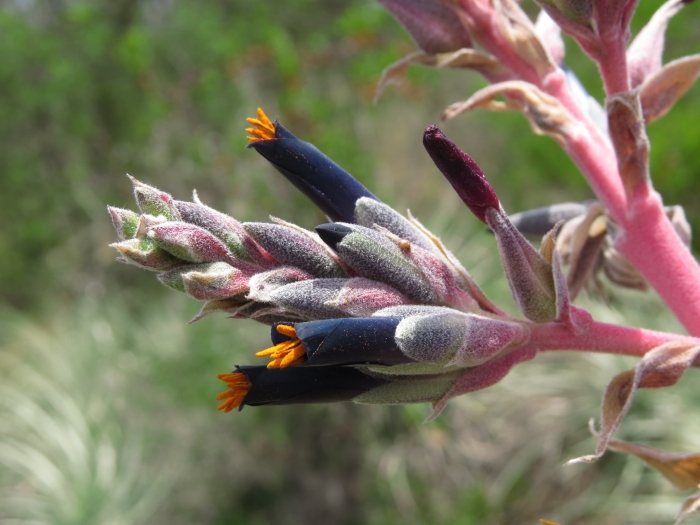Blue Puya
(Puya coerulea)
Blue Puya (Puya coerulea)
/
/

Nicolás Lavandero
CC BY 4.0
Image By:
Nicolás Lavandero
Recorded By:
Copyright:
CC BY 4.0
Copyright Notice:
Photo by: Nicolás Lavandero | License Type: CC BY 4.0 | License URL: http://creativecommons.org/licenses/by/4.0/ | Rights Holder: Nicolás Lavandero | Publisher: iNaturalist | Date Created: 2020-11-17T13:21:02-08:00 |

























Estimated Native Range
Summary
Puya coerulea, commonly known as the Blue Puya, is an evergreen perennial herb native to the sclerophyllous woodlands and rocky slopes of central Chile. It is particularly adapted to the Mediterranean climate of its native range, with hot, dry summers and cool, wet winters. Blue Puya can reach a height of 3-4 feet (0.9-1.2 meters) with a similar spread, and it forms a rosette of narrow, spiny, silver-green leaves. The plant is renowned for its striking metallic turquoise to navy blue flowers, which appear on tall spikes in the spring and early summer and are exceptionally showy, attracting both gardeners and pollinators alike.
The Blue Puya is valued in cultivation for its unique flower color and architectural form, making it a focal point in xeriscapes, rock gardens, and as a specimen plant in botanical collections. It requires minimal maintenance once established, tolerating drought and poor soils, although it performs best in well-drained, sandy or gravelly soils. Full sun is essential for optimal growth and flowering. While generally disease-free, it can be susceptible to root rot if overwatered. Blue Puya is not commonly found in cultivation, but when available, it offers a dramatic and exotic element to the garden.CC BY-SA 4.0
The Blue Puya is valued in cultivation for its unique flower color and architectural form, making it a focal point in xeriscapes, rock gardens, and as a specimen plant in botanical collections. It requires minimal maintenance once established, tolerating drought and poor soils, although it performs best in well-drained, sandy or gravelly soils. Full sun is essential for optimal growth and flowering. While generally disease-free, it can be susceptible to root rot if overwatered. Blue Puya is not commonly found in cultivation, but when available, it offers a dramatic and exotic element to the garden.CC BY-SA 4.0
Plant Description
- Plant Type: Succulent
- Height: 2-3 feet
- Width: 2-3 feet
- Growth Rate: Slow
- Flower Color: Purple
- Flowering Season: Spring
- Leaf Retention: Evergreen
Growth Requirements
- Sun: Full Sun, Part Shade
- Water: Low
- Drainage: Fast, Medium
Common Uses
Border Plant, Drought Tolerant, Low Maintenance, Rock Garden, Showy Flowers
Natural Habitat
Sclerophyllous woodlands and rocky slopes in central Chile
Other Names
Common Names: Sapphire Tower
Scientific Names: , Puya coerulea, Pitcairnia coerulea, Pitcairnia coerulea, Pourretia caerulea,
GBIF Accepted Name: